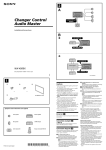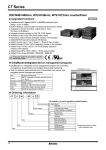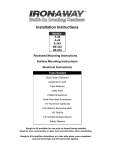Download VDS2510 Installation Manual
Transcript
VDS2510 Installation Manual VDS2510 Installation Manual Video Signal Output No. 1 N.O. Alarm N.C. Output Ground Audio Out N.O. Alarm C N.C. Output Ground Audio Out VDS2510 Installation Manual C Viewer 2510-L (Local Unit) Video Signal Output No. 2 Sender 2510-R (Remote Unit) OUTPUT Connections There are two VIDEO OUT connectors. Please connect each connector with a cable to a device, e.g. a monitor. There are two Audio OUT connectors. Please connect each connector with a cable to a device, e.g. a monitor or a speaker. There are two ALARM OUT connectors. Please link the N.C. N.O. connect from each of the ALARM OUT connectors to other further application devices. Distributor/Retailer Copyright (c) 2006, All Rights Reserved. Content Introduction .........................................................2 Features .............................................................2 Packing Checklist....................................................2 Certificate ..........................................................2 Patents ..............................................................2 Limited Warranty .....................................................2 Specification of VDS2510-R Sender ...................................3 Specification of VDS2510-L Viewer ...................................3 Functions of Remote Unit(VDS2510-R Sender) ..........................4 Functions of Local Unit(VDS2510-L Viewer) ...........................5 Installation of Remote Unit and Local Unit ..........................6 Making Connection....................................................8 Installation Notice..................................................8 Connecting Sender Unit...............................................9 Connecting Viewer Unit .............................................11 Foresight CCTV, Inc. Email: [email protected] Made in Taiwan 047ab, May. 2006 www.foresight-cctv.com 047ab, May. 2006 VDS2510 Installation Manual VDS2510 Installation Manual Introduction The VDS2510 series is a transmission system for sending two video, two audio, two alarm signals and DC power through one coaxial cable. The system can transmit signals and 12VDC power up to 800 meters. If a camera is powered at the remote end, without DC power supplying from Viewer, the transmission distance of the VDS2510 can reach 1,000 meters. Connecting Viewer unit The following illustration shows the connections for the Viewer unit: Features Link In DC power can be sent to the Remote side for cameras power Link Fault Indication consumption. System Status LINK IN & One cable transmits all signals and DC power. & Universal Voltage Input (85V~265V). & Up to 800 meters transmission range while sending DC power from the Viewer unit; up to 1,000 meters transmission range when cameras have another power source. & Real time analog video signals for color and B/W (50fps/60fps), better than 480TVL resolution. & Built-in electrical transient voltage suppressor (TVS) protection, gas tube arrester protection and lightning protection & Inter-carrier technology eliminates signal interference. & Accept both N.C. or N.O. alarm connection, or mix of N.C. and N.O. In Term mode. DC40V Packing Checklist Carefully unpack the VDS2510 and check that the following items are included: & VDS2510-R Sender (Remote Unit) & VDS2510-L Viewer (Local Unit) & Power supply (AC to DC power adapter) and power cord & Four mounting brackets and four screws & Two 1,000 ohms terminators for alarm mode use in Alarm Input side. & Installation Manual Contact your dealer immediately if any of the above items appears damaged or the unit does not work. Certificate This equipment has been tested and found to comply with the Part 15 rules of the US FCC Regulation, and gets CE approved. DC Power Input LINK IN Connections Connect the other end of the coaxial cable which is connected to the LINK OUT side of the Sender unit to the LINK IN side of the Viewer unit. Connect a wire from the +12V pin and Out of the LINK FAULT PTB connector to a buzzer or an indicator wherever you want. Plug the power cord on and connect the AC to DC power adapter to the DC POWER IN connector in the LINK IN side of the Viewer unit. Patents Patents covering the design, operation, techniques, and unique features of the Single-cable transmission device of a surveillance system include: U.S. Patent #US 6,369,699 B1 April 9, 2002; Taiwan Patent #201389 September 3 2004; Europe Patent #EP 1134909 A1 September 19, 2001. Other Patents are pending. Limited Warranty Foresight grants a warranty for this product for 18 months. Please offer the purchase date and the serial Number of Bar-Code on the back of the product to your distributor or retailer as proof for this purpose . During the warranty period, in case of defected in material or workmanship, the defective unit will be repaired or replaced according to the assessment of. However, this warranty does not cover damages caused by improper use or from unauthorized modifications by third parties. -2- 047ab, May. 2006 - 11 - 047ab, May. 2006 VDS2510 Installation Manual VDS2510 Installation Manual Specification of VDS2510-R Sender To ensure smooth operation of VDS2510, the following minimum system and setup requirements should be met. LINK OUT Link Out Power Status Alarm Input Type Selector Coaxial cable is used for Link Out to send broadband signals: 2 video, 2 Audio and 2 alarm signals. Coaxial Cable 1 to 800Metres use RG-6/u or Equivalents Electrical: All video, Audio and Alarm have two inputs Video Input Signal: 1.0Vpp, 75 ohms Bandwidth of Video Signal: 5.5MHz typ. Audio Input Signal: 3.0Vpp, 100K ohms, max Alarm Input type: N.C./N.O./Terminal 1,000 ohms Power Output: DC12V, 1.0 A(2 cameras in total), max. Connection : (PTB= Plugable Terminal Block) Video Input: BNC Socket X 2 Audio Input, Alarm Input and DC Out: 5 Pin PTB X 2, 3.5mm Pitch Link Out: BNC Socket LED here can indicate the Alarm connecting Specification of VDS2510-L Viewer Electrical: LINK OUT Connection Connect the LINK OUT of Sender unit with one end of a coaxial cable, and connect the other end of the coaxial cable to the LINKIN side of All video, Audio and Alarm have two outputs Video Output Signal: 1.0Vpp, 75 ohms Bandwidth of Video Signal: 5.5MHz typ. S/N ratio of Video Signal: 50dB typ. Gain of Audio signal Output: 0dB ∮3dB, 600 ohms / internal impedance Bandwidth of Audio Signal: 50Hz to 10KHz ∮3dB S/N Ratio of Audio Signal: 46dB under 1.0Vpp input at RU Alarm Output: N.C./N.O., Contact Rating 1A, 30VDC Dry contact DC Power Input: 40V Max. DC power Output: 38V, 1.6A, min. Link Fault Output : 0.15A, min. Connection : (PTB= Plugable Terminal Block) Link In: BNC Socket Link Fault: 2 Pin PTB, 3.5mm Pitch DC Power Input: 2 Pin PTB, 5.0mm Pitch Video Output: BNC Socket X 2 Audio Output and Alarm Output: 5 Pin PTB X 2, 3.5mm Pitch - 10 - 047ab, May. 2006 -3- 047ab, May. 2006 VDS2510 Installation Manual VDS2510 Installation Manual Functions of Remote Unit Connecting Sender unit The following illustration shows the connections for the Sender VDS2510-R Sender INPUT side VIDEO IN: to receive a video signal from video source, eg. a camera. AUDIO IN: to receive an audio signal from an audio source, eg. a microphone. ALARM IN: to receive alarm connection from devices like sensors or infra-red detective devices. Both N.O. and N.C. are acceptable, even at the same time(under the TERM). DC OUT: to send 12VDC power to cameras. LINK OUT Side LINK OUT with DC IN: to send out two video, two audio, two alarm signals to the Viewer unit and to receive DC power from the Viewer unit. POWER STATUS LED: to indicate the power supplying condition. When LED is red, it implies the power supplying to camera is stand-by or not been used. When LED is green, it means the power is loaded well to the camera. When LED is Yellow, it means the DC power is low. Please check if the cable used is over length limitation or the DC consumption of the two cameras in total is more than 1.0A (note1). When LED is flashing, it implies the power supply might be failed due to the power is too low to offer any function. ALARM Video Signal Input No. 1 Audio Signal In Ground Alarm Sensor In DC 12V Out Audio Signal In Ground Alarm Sensor In DC 12V Out Video Signal Input No. 2 INPUT Connection LED: to indicate the Alarm Input and Alarm Output are both well working. CONNECTION INPUT TYPE: to let users to select which alarm connection type to apply: N.C. or N.O. or TERM (mixed with N.O. and N.C.) Note 1. The 1.0A is based on the condition of less than 600M distances and 5C-2V coaxial cable used. Please refer to How to Use Alarm manual enclosed. There are two VIDEO IN connectors. Please connect each VIDEO IN connector with one end of a cable carrying video signal from the video source. There are two AUDIO IN connectors. Please connect each AUDIO IN connector with one end of a cable carrying audio signal from the audio source. There are two ALARM IN connectors. Please connect each PTB connector in ALARM IN with a wire with the N.O./N.C. connection from sensors. Please refer to How to Use Alarm manual to improve security and flexibility of alarm connection. There are two DC OUT connectors. Please connect each DC OUT connectors with the power cord (DC 12V) to the video source, e.g. a camera. -4- 047ab, May. 2006 -9- 047ab, May. 2006 VDS2510 Installation Manual VDS2510 Installation Manual Making Connection Functions of Local Unit The following illustration gives an overview of the Sender unit and the Viewer unit connections. VDS2510-L Viewer No. 2 Video Signal Output N.O. Alarm N.C. Output Ground Audio Out N.O. Alarm C N.C. Output Ground Audio Out DC POWER IN: to input the power from the power supply. OUTPUT side DC Power Input ALARM OUT: to send the alarm connection out for a further application. LED: To indicate the alarm function is operating. DC40V System Status AUDIO OUT: to send out the audio signals to a device, e.g. monitor or loudspeaker amplifier. The audio signal level output from the AUDIO OUT is exactly the same as what the AUDIO IN received at Sender Unit. DC Power Supply Link Fault Indication VIDEO OUT: to send the video signals out to a device, e.g. A monitor or DVR Link In Video Signal Input Audio Signal In Ground Alarm Sensor In DC 12V Out Audio Signal In Ground Alarm Sensor In DC 12V Out C No. 1 Video Signal Output SYSTEM STATUS LED: When users turn off the system, LED will be red. When users turn on the system, LED will be yellow at the first 5 seconds for initial, and then become green. The LED will keep green, when the system is on. ON/OFF: to turn on or turn off the system No. 2 No. 1 Video Signal Input LINK IN with DC OUT: to receive in two video, two audio, and two alarm signals from the Sender unit and also to send DC power out to the Sender unit. LINK FAULT: to warn users if the cable between Sender unit and Viewer unit is disconnected. To allow users to send the warning signal to an extra warning device, e.g. buzzer, relay or light bulb and everyplace users prefer. DC Power to CCD Cameras 2 Video and 2 Alarm Signals Alarm Input Type Selector Power Status Link Out Coaxial Cable 0 to 800Meter use 5C-2V or Equivalence LINK IN side Installation Notice When setting up the VDS2510 Sender unit and Viewer unit, be sure to note the following points: Both units should be fixed securely to a permanent object such as a wall or a pillar. Avoid locations with extreme vibrations or dust. Avoid locations with dampness or extreme heat. -8- 047ab, May. 2006 -5- 047ab, May. 2006 VDS2510 Installation Manual VDS2510 Installation Manual I n s t a l l a t i o n o f R e m o t e a n d L o c al Units The VD S2 51 0 u nit s ca n bo t h be fi x e d to a w a l l o r d e s k t o p w i t h the su pp li ed mou n t i n g br a c k e t s . Th e mo u n t i n g b r a c k e t s c a n be f ix ed on to th e re a r , to p , or bo t t o m of e i t h e r u n i t . A tt a c h i n g t he Mounting Bracke t s Att ac h t he mo unt i n g br a c k e t s to ei t h e r th e S e n d e r u n i t o r the vi ew er un it as sh o w n be l o w : 1. Alig n t he mo un tin g br a c k e t wi t h th e mo u n t i n g t r a c k o n t h e rear of th e u ni t as sh o w n he r e : 4. Fix the unit in the desired location with two screws. Removing the Mounting Brackets Remove the mounting as shown below: 1. Use a flat-tipped screwdriver to lift the white nub as shown below: Mounting Tracks Nub 2. Slid e t he br ac ket in th e di r e c t i o n of th e a r r o w u n t i l t h e white n ub cl ic ks int o pl a c e as sh o w n be l o w : 2 . W h i l e l i f t i ng the nub, slide the bracket out in the d i r e c t i o n o f t he arrow as shown below: Nub 3. Repe at th e a bo ve st e p s on an o t h e r si d e of t h e u n i t t o a t t a c h the s ec on d b ra ck et . 3 . R e p e a t t h e a bove steps to remove the second bracket. -6- 047ab, May. 2006 -7- 047ab, May. 2006

















